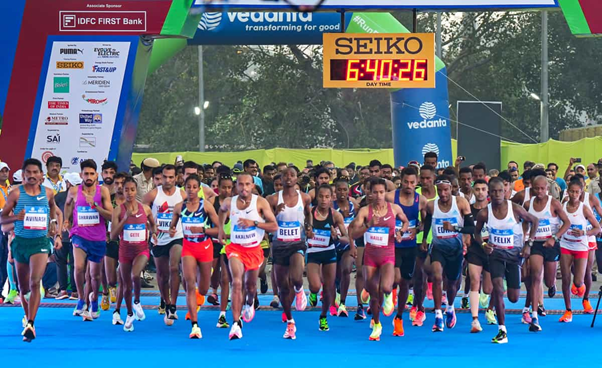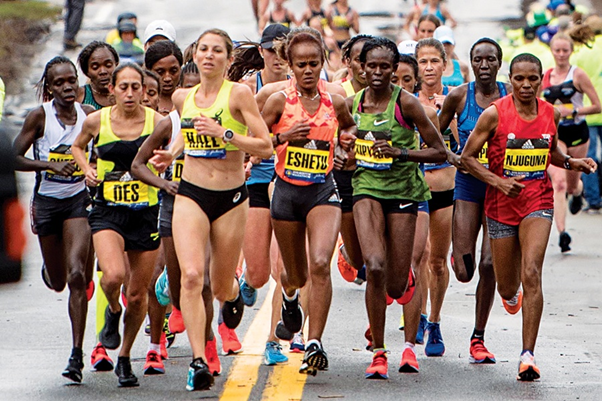“Marathoning. The triumph of desire over reason.”

The 40-km run that the Greek courier Philippides made from the battleground of Marathon to Athens to announce the defeat of the invading Persians remained a traditional story for twenty-four hundred years. That is, till it was made into a men’s road running event, named marathon, in the first Olympics in 1896. Although many women ran marathon distance from 1896 onward, women’s marathon in Olympics was introduced in 1984. Marathon is the only road running event at Olympics. It is, one may say, the crowning glory of Olympics. Men’s marathon is the last event of the athletics calendar, on the final day of the Olympics.
Marathon has gained popularity
The marathon at the first Olympics had only seventeen runners. Today, the world has about 2500-4000 marathon and long-distance races with about one crore runners each year. And 52% to 55% of runners are first timers. The US has eleven hundred marathons and about six lakh runners, China has over one hundred marathons and about four lakh runners, and India has over sixty marathons and about three lakh runners, each year.
Istanbul marathon runs in two continents, Asia, and Europe. Three marathons in the US runs in two countries, the US and Canada. And the ‘three countries marathon’ runs in three countries, Germany, Switzerland, and Austria.
Marathon superheroes
Fauja Singh, the oldest person to complete a marathon race at age 100 was of Indian origin. Budhia Singh the youngest to run a marathon distance at age five is an Indian. Harriette Thompson was the oldest woman to finish a marathon at age 94. Patrick Finney has multiple sclerosis, a disease that makes walking. difficult, but has finished over 71 marathons. Terry Fox with one artificial leg ran average of over 37 kilometres (marathon distance is 42.195 km) for 143 consecutive days. Larry Macon set a record by running 238 marathons in a year. Stefaan Engels ran 365 marathon distances in 365 days. Christian Hottas completed a record 2500 marathons. These superheroes have inspired people young and old to take to marathon and long-distance running.
Medical issues
Marathon is a gruelling race. But the runners are fit. The causalities mostly are minor injuries, such as blisters, knee or ankle strains and sprains, tendinitis, and fatigue and dehydration.
Fatigue. Runners burn glycogen in the body for quick energy. Glycogen usually runs out at about thirty kilometres of running. The runner then has dramatic fatigue and finds running difficult. And is said to have “hit the wall.” Runners use carbohydrate-based energy gels that contain sodium and potassium, and some may also contain caffeine, to reduce the effect of hitting the wall. Gels are to be taken with water. How much of gels to take and how often to take during the race varies with individual runners.
Hydration. On a hot day, a racer may lose up to four litres of fluid through sweating and exhaling. Dehydration is thus a big threat. Racers drink sports drinks which contain electrolytes and carbohydrates instead of plain water. But drinking excessive amounts of fluids can cause dilution of sodium in the blood, a condition called exercise-associated hyponatremia, which may result in vomiting, seizures, coma and even death. No racer has died of dehydration. But several racers have died of hyponatremia. Women are more prone to hyponatremia than men. Dr. Cynthia Lucero, age 28, suffered hyponatremia when running the 2002 Boston Marathon and died two days later. Advice is that racers should “drink to thirst,” not drink at every fluid station.
Cardiac. Marathon has a transient and low risk of sudden cardiac death. The US had 59 sudden cardiac arrests and 42 deaths among 10.9 million runners. The risk of cardiac arrest in men was five times that of in women.
Mortality The mortality risk in those who completed the marathon was about 1 per 100,000 in men, and 1 per 240,000 in women. The risk of death in a race, 0.5 to 2 deaths per 100,000 marathoners, is far lower than the risk of death in most of daily activities. Advice to the runners is to seek medical help in case of difficulty in breathing, new and unexplained weakness, any pain, or chest pain.
Sudden death during long distance races is rare. But it is beginning to appear more common because of the huge increase in the number of runners. And though the number of deaths is statistically extremely small, each death devastates the family.
Why people run marathon and long-distance races
Prize money for the top finishers, 30-80 lakh rupees for the winner in richest marathons, may be a motivator for the elite runners especially from the African countries. Elite runners are those with marathon timings of sub 2:13 hours for men and sub 2:35 hours for women. But most of the runners are amateurs and have no hope of being among the top finishers and therefore prize money is not the motivator for them.
For the amateurs, to overcome the challenge of a marathon is an important motivator. But a greater awareness of the health benefits of running is perhaps the most important motivator. Running improves cardiovascular fitness, bone density, and combined with yoga, swimming and cycling can increase muscle strength and flexibility. It protects against later-age osteoporosis. It can decrease blood pressure, resting heart rate and cancer risk. It may reverse aortic stiffening caused by aging. And it may reduce stress and mental tension and sharpen brain. In a survey, over 89% of runners said that it positively impacted their motivation, body image and mental health and made them happier. These impacts were greater on women.
Marathon builds up lactic acid and other waste products which cause pain, fatigue, and weakness. A week or more of rest or only light physical exercise is needed to recover from these.
Marathon is run not only with legs but also with mind. Anyone and everyone can run a marathon after proper training. Because to run a marathon you do not have to be overly tough. Only tough enough not to quit. And despite the pain, “the marathon never ceases to be a race of joy, a race of wonder,” says Hal Higdon.
